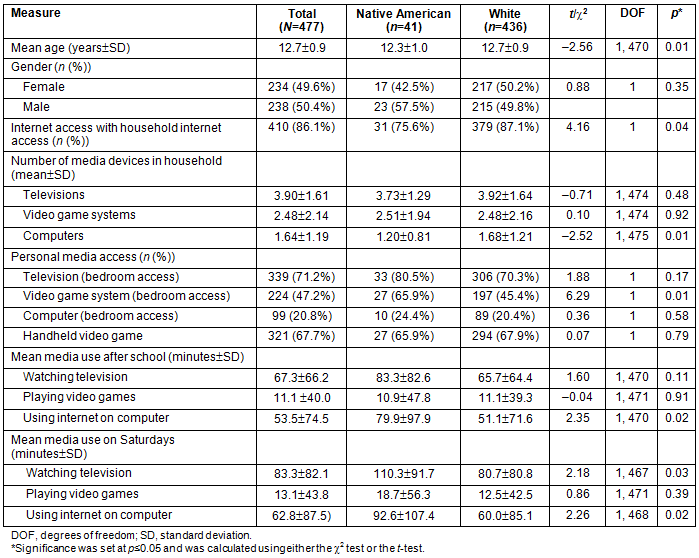Compared to other minority groups in the USA, Native American children experience the highest disparities from White children in both the number and magnitude of health-related diseases1. Multimedia-based health interventions, delivered through platforms such as the internet or video games, afford valuable opportunities for reaching Native American children, given that such approaches can overcome geographic barriers and have emerged as effective for targeting other underserved minority groups2,3. Web-based interventions, for example, are not only cost-effective but have demonstrated high acceptance among youth, given that they can be tailored to each individual's needs and can incorporate interactive features4,5. Despite the promise of media technologies, success of these interventions is dependent upon the target audience using the medium that is delivering the message. To date, however, there have been limited data describing media access and use among Native American youth. Even widely available population reports of children's media use commissioned by the US Government6, or from the Pew Research Center7 or the Kaiser Foundation8 have included few if any details regarding rates of media use among Native Americans.
To the authors' knowledge, there is only one prior report describing media use in Native American youth, which included a sample of urban and rural youth aged 13-21 from the Pacific Northwest region9. The objective of the current study was to expand on this prior work by characterizing media access and use among rural Native American children and to compare rates of media use with White children residing in the same rural area. Given the extensive diversity that exists between Native American groups10, findings regarding media use in one geographic region may not be consistent or applicable to Native Americans from other regions9. In this cross-sectional study, all the children surveyed were from the rural Upper Peninsula of Michigan, a Midwestern region where Native American culture and customs differ considerably from those in other regions of the USA11. Further, this represents the first direct cross-cultural comparison of media use between Native American and non-Native American children, which will help to guide the development or adaptation of existing multimedia-based health interventions specifically targeting this at-risk group.
Survey data were collected as part of a larger evaluation trial of a media reduction intervention across four public middle schools in the rural Upper Peninsula of Michigan12. This report presents secondary analyses of the baseline data collected within the larger trial. Parental consent was obtained for all students.
Participants reported their personal media access by indicating whether they owned each media device (television, video game system, and/or computer) and whether each of these devices were situated within their bedroom. Household media access was assessed by the total number of each of these devices participants reported being located within their home. Media exposure was measured by self-reported use 'after school' and 'Saturday'. Participants estimated on an 8-point scale the amount of time (1=none, 2=15 minutes, 3=30 minutes, 4=1 hour, 5=2 hours, 6=3 hours, 7=4 hours, 8=5 hours or greater) they spent using each of the following types of media: television, video game systems, and computer/internet. Differences in media ownership and use between Native American and White children were compared by χ² and t-tests. Significance was set at p≤0.05.
Ethics approval
The Boston Children's Hospital Institutional Review Board approved the data management and analysis (Z09-12-0657).
Of the 622 survey respondents, the 477 who reported their race to be White (n=436) or Native American (n=41) were included in this study. This final sample included students in grades 6-8, aged 10-15 years (mean (M)=12.7; standard deviation (SD)=0.91), and had an approximately even distribution of boys and girls (49.6% female). In regards to differences in personal access to media devices (Table 1), Native Americans were more likely to have a video game system in their bedroom (65.9%) than were Whites (45.4%; p=0.04). No between-group differences were observed for television or computer access in the bedroom or personal ownership of handheld video games.
White households had more internet access (87% vs 66%; p=0.04) and had greater computer ownership (1.68 computers vs 1.20 computers; p=0.01) than Native American households. No differences were observed for the number of household televisions or video game systems owned between groups. Time spent using computers to access the internet was higher among Native American than among White children after school (79.8 min vs 51.0 min; p=0.02) and on Saturdays (92.4 min vs 60.0 min; p=0.02). On Saturdays, Native American children watched more television than White children (110.2 min vs 80.7 min; p=0.03).
Table 1: Demographics, internet access, and household and personal media access
and use in Native American compared to White children from rural Michigan

Discussion
Prior reports have found that Native American adults13 as well as youth9 use diverse media, including the internet, at equivalent or higher rates than the US national average. A recent study of First Nations youth in Ontario, Canada, similarly found elevated rates of television and video game use14. The current study expands on these findings and is the first to demonstrate that within a sample of school children aged 10-15 years from the rural Upper Peninsula of Michigan, Native American children use computers to access the internet more often than their White counterparts. Interestingly, this greater use comes despite significantly lower home access, a finding that may be attributable to the social and economic disparities affecting Native American communities15. Additionally, it is possible that the elevated rates of internet use on weekdays and Saturdays, and television use on Saturdays only, among Native American children may be reflective of their home environment16 or residing in neighborhoods with poor social conditions17. For example, research has shown that children use more media when they model the behaviors of parents or siblings, if household rules or restrictions on media use are inconsistent or absent altogether, and when there are inadequate opportunities for safe outdoor play in their neighborhoods16. The lack of differences observed between groups with regards to access to televisions and handheld video games could be explained by the fact that these devices are older, resulting in greater downstream uptake within lower income populations such as Native Americans.
Consistent with Rushing et al's9 prior work, the findings from the present study suggest that current media, such as the internet, is central to daily life among Native American children who have access to computers. This reinforces the notion that these types of media may represent valuable mechanisms for delivering health-based interventions to this population. While there are a small number of web-based efforts available that target health behaviors among Native American youth3,4,18, the results from this study suggest that these efforts could be continued and expanded to even younger individuals. However, such an expansion would need to be accompanied by an effort to increase access in order to maximize the impact of the programs. This is particularly important given that communities with less access to current media technologies are also at a larger disadvantage than communities with higher access when it comes to important social outcomes such as obtaining better education, employment, and civic participation15.
By highlighting that a variety of media technologies are relevant to Native American children residing in rural Michigan, this study contributes to a limited body of research in this area and further provides emphasis for the need to conduct rigorous evaluation studies in order to determine the impact and effectiveness of culturally tailored multimedia-based health interventions for use in this population group. As public health officials and researchers work to reduce health disparities within this population, they should consider adapting web-based programs targeting relevant health behaviors with Native American-specific cultural attributes5,9 in order to appeal to the needs and interests of these underserved youth.
Acknowledgements
Funding was provided by the US Department of Education: Office of Safe and Drug Free Schools, Carol M. White Physical Education Program (PEP) grant (Q215F050099) (PI: Bickham). This work was also supported by the Delta-Schoolcraft Intermediate School District and Lt Colonel David Grossman.
References
1. Flores G, Tomany-Korman SC. Racial and ethnic disparities in medical and dental health, access to care, and use of services in US children. Pediatrics 2008; 121(2): e286-e298.
2. Gao Z, Hannan P, Xiang P, Stodden DF, Valdez VE. Video game-based exercise, Latino children's physical health, and academic achievement. American Journal of Preventive Medicine 2013; 44(3): S240-S246.
3. Bowen DJ, Henderson PN, Harvill J, Buchwald D. Short-term effects of a smoking prevention website in American Indian youth. Journal of Medical Internet Research 2012; 14(3): e81.
4. Raghupathy S, Forth ALG. The HAWK2 Program: a computer-based drug prevention intervention for Native American youth. American Journal of Drug and Alcohol Abuse 2012; 38(5): 461-467.
5. Rushing S, Stephens D. Tribal recommendations for designing culturally appropriate technology based sexual health interventions targeting Native youth in the Pacific Northwest. American Indian and Alaska Native Mental Health Research 2012; 19(1): 76-101.
6. National Telecommunications and Information Administration. Exploring the digital nation: America's emerging online experience. Washington, DC: US Department of Commerce, 2013.
7. Lenhart A, Purcell K, Smith A, Zickuhr K. Social media and mobile internet use among teens and young adults. Washington, DC: Pew Internet & American Life Project, 2010.
8. Rideout VJ, Foehr UG, Roberts DF. Generation M2: media in the lives of 8- to 18-year-olds. Menlo Park, CA: Henry J. Kaiser Family Foundation, 2010.
9. Rushing SC, Stephens D. Use of media technologies by native American teens and young adults in the Pacific Northwest: exploring their utility for designing culturally appropriate technology-based health interventions. Journal of Primary Prevention 2011; 32(3-4): 135-145.
10. Christopher S, Watts V, McCormick AKHG, Young S. Building and maintaining trust in a community-based participatory research partnership. American Journal of Public Health 2008; 98(8): 1398-1406.
11. Cleland CE. Rites of conquest: the history and culture of Michigan's Native Americans. Ann Arbor, MI: University of Michigan Press, 1992.
12. Bickham DS, Hswen Y, Paulsen K. Efficacy of a school based intervention to reduce screen media time for 6th-8th graders. Paper presented at the annual meeting of the International Communication Association. London, England, 2013.
13. Morris TL, Meinrath SD. New media, technology and internet use in Indian country: quantitative and qualitative analyses. Washington, DC: New America Foundation, 2009.
14. Gates M, Hanning R, Martin I, Gates A, Tsuji L. Body mass index of First Nations youth in Ontario, Canada: influence of sleep and screen time. Rural and Remote Health 13: 2498. (Online) 2013. Available: www.rrh.org.au (Accessed 13 November 2013).
15. Bissell T. The digital divide dilemma: preserving Native American culture while increasing access to information technology on reservations. Journal of Law, Technology and Policy 2004: 129-150.
16. Granich J, Rosenberg M, Knuiman M, Timperio A. Understanding children's sedentary behaviour: a qualitative study of the family home environment. Health Education Research 2010; 25(2): 199-210.
17. Singh GK, Siahpush M, Kogan MD. Neighborhood socioeconomic conditions, built environments, and childhood obesity. Health Affairs 2010; 29(3): 503-512.
18. Taualii M, Bush N, Bowen DJ, Forquera R. Adaptation of a smoking cessation and prevention website for urban American Indian/Alaska Native youth. Journal of Cancer Education 2010; 25(1): 23-31.


